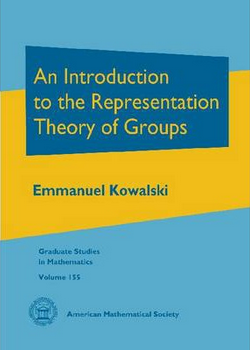
An Introduction to the Representation Theory of Groups
[BOOK DESCRIPTION]
Representation theory is an important part of modern mathematics, not only as a subject in its own right but also as a tool for many applications. It provides a means for exploiting symmetry, making it particularly useful in number theory, algebraic geometry, and differential geometry, as well as classical and modern physics. The goal of this book is to present, in a motivated manner, the basic formalism of representation theory as well as some important applications. The style is intended to allow the reader to gain access to the insights and ideas of representation theory--not only to verify that a certain result is true, but also to explain why it is important and why the proof is natural. The presentation emphasizes the fact that the ideas of representation theory appear, sometimes in slightly different ways, in many contexts. Thus the book discusses in some detail the fundamental notions of representation theory for arbitrary groups. It then considers the special case of complex representations of finite groups and discusses the representations of compact groups, in both cases with some important applications.There is a short introduction to algebraic groups as well as an introduction to unitary representations of some noncompact groups. The text includes many exercises and examples.
[TABLE OF CONTENTS]
Chapter 1 Introduction and motivation 1 (12)
1.1 Presentation 3 (1)
1.2 Four motivating statements 4 (4)
1.3 Prerequisites and notation 8 (5)
Chapter 2 The language of representation theory 13 (114)
2.1 Basic language 13 (8)
2.2 Formalism: changing the space 21 (21)
2.3 Formalism: changing the group 42 (23)
2.4 Formalism: changing the field 65 (3)
2.5 Matrix representations 68 (2)
2.6 Examples 70 (10)
2.7 Some general results 80 (41)
2.8 Some Clifford theory 121(3)
2.9 Conclusion 124(3)
Chapter 3 Variants 127(32)
3.1 Representations of algebras 127(5)
3.2 Representations of Lie algebras 132(7)
3.3 Topological groups 139(6)
3.4 Unitary representations 145(14)
Chapter 4 Linear representations of finite 159(110)
groups
4.1 Maschke's Theorem 159(4)
4.2 Applications of Maschke's Theorem 163(6)
4.3 Decomposition of representations 169(21)
4.4 Harmonic analysis on finite groups 190(10)
4.5 Finite abelian groups 200(8)
4.6 The character table 208(32)
4.7 Applications 240(22)
4.8 Further topics 262(7)
Chapter 5 Abstract representation theory of 269(50)
compact groups
5.1 An example: the circle group 269(3)
5.2 The Haar measure and the regular 272(16)
representation of a locally compact group
5.3 The analogue of the group algebra 288(6)
5.4 The Peter邑eyl Theorem 294(10)
5.5 Characters and matrix coefficients for 304(6)
compact groups
5.6 Some first examples 310(9)
Chapter 6 Applications of representations of 319(36)
compact groups
6.1 Compact Lie groups are matrix groups 319(5)
6.2 The Frobenius-Schur indicator 324(8)
6.3 The Larsen alternative 332(12)
6.4 The hydrogen atom 344(11)
Chapter 7 Other groups: a few examples 355(54)
7.1 Algebraic groups 355(14)
7.2 Locally compact groups: general remarks 369(2)
7.3 Locally compact abelian groups 371(5)
7.4 A non-abelian example: SL2(R) 376(33)
Appendix A Some useful facts 409(12)
A.1 Algebraic integers 409(5)
A.2 The spectral theorem 414(6)
A.3 The Stone邑eierstrass Theorem 420(1)
Bibliography 421(4)
Index 425

 新书报道
新书报道